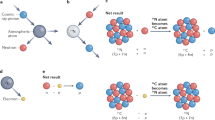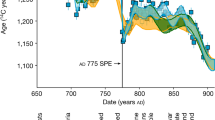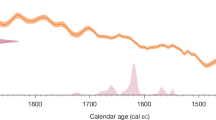Abstract
IN a recent communication, C. Crowe1 uses published dates on samples of known age in an attempt to investigate variations of the concentration of carbon-14 in living material during the past 5,000 years. He concludes that the activity has followed a cycle with a maximum change of 10 per cent and with some evidence of a sharp peak of about 10 per cent about 2,000 years ago. His proposed curve is most striking, for the effect, if real, would imply, for example, that all 1,000-year old samples should give radiocarbon ages of more than 1,700 years, a result which has not yet been obtained in practical measurement despite the growing number of accurate measurements on tree rings and other materials of known age.
This is a preview of subscription content, access via your institution
Access options
Subscribe to this journal
Receive 51 print issues and online access
$199.00 per year
only $3.90 per issue
Buy this article
- Purchase on SpringerLink
- Instant access to full article PDF
Prices may be subject to local taxes which are calculated during checkout
Similar content being viewed by others
References
Crowe, C., Nature, 182, 470 (1958).
de Vries, Hl., Proc. K. Ned. Akad. Wetensch., B, 61, 94 (1958).
Münnich, K. O., Science, 126, 194 (1957).
Author information
Authors and Affiliations
Rights and permissions
About this article
Cite this article
BARKER, H. Carbon-14 Activity during the Past 5,000 Years. Nature 182, 1433 (1958). https://doi.org/10.1038/1821433a0
Issue date:
DOI: https://doi.org/10.1038/1821433a0
This article is cited by
-
Relative und absolute Datierungen quart�rer Ablagerungen
Die Naturwissenschaften (1961)
-
Radiocarbon Measurements on Samples of Known Age
Nature (1959)



